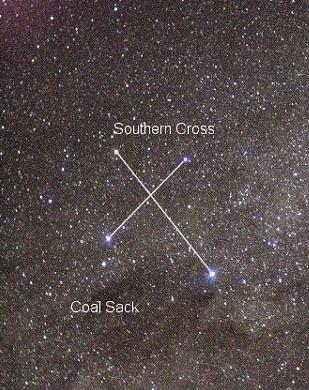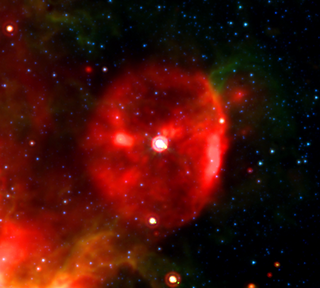
Iota Orionis is a multiple star system in the equatorial constellation of Orion the hunter. It is the eighth-brightest member of Orion with an apparent visual magnitude of 2.77 and also the brightest member of the asterism known as Orion's Sword. It is a member of the NGC 1980 open cluster. From parallax measurements, it is located at a distance of roughly 1,340 light-years from the Sun.
3 Centauri is a triple star system in the southern constellation of Centaurus, located approximately 300 light years from the Sun. It is visible to the naked eye as a faint, blue-white hued star with a combined apparent visual magnitude of 4.32. As of 2017, the two visible components had an angular separation of 7.851″ along a position angle of 106°. The system has the Bayer designation k Centauri; 3 Centauri is the Flamsteed designation. It is a suspected eclipsing binary with a variable star designation V983 Centauri.

HD 93250 is a highly luminous hot blue binary star in the Carina Nebula in the constellation Carina.
Cygnus OB2 #8A is a double-lined spectroscopic binary located near the centre of the Cygnus OB2 association located 5,500 light years away.

HR Carinae is a luminous blue variable star located in the constellation Carina. It is surrounded by a vast nebula of ejected nuclear-processed material because this star has a multiple shell expanding atmosphere. This star is among the most luminous stars in the Milky Way. It has very broad emission wings on the Balmer lines, reminiscent from the broad lines observed in the spectra of O and Wolf–Rayet stars. A distance of 5 kpc and a bolometric magnitude of -9.4 put HR Car among the most luminous stars of the galaxy.

HD 150136 is a multiple star system in the southern constellation of Ara, around 4,300 light years away. It is the brightest member of the faint open cluster NGC 6193, part of the Ara OB1 association.

HD 48099 is a spectroscopic binary in the constellation Monoceros where both components are massive and luminous O stars.

WR 22, also known as V429 Carinae or HR 4188, is an eclipsing binary star system in the constellation Carina. The system contains a Wolf-Rayet (WR) star that is one of the most massive and most luminous stars known, and is also a bright X-ray source due to colliding winds with a less massive O class companion. Its eclipsing nature and apparent magnitude make it very useful for constraining the properties of luminous hydrogen-rich WR stars.

HD 168625 is a blue hypergiant star and candidate luminous blue variable located in the constellation of Sagittarius easy to see with amateur telescopes. It forms a visual pair with the also blue hypergiant HD 168607 and is located to the south-east of M17, the Omega Nebula.

HD 168607 is a blue hypergiant and luminous blue variable (LBV) star located in the constellation of Sagittarius, easy to see with amateur telescopes. It forms a pair with HD 168625, also a blue hypergiant and possible luminous blue variable, that can be seen at the south-east of M17, the Omega Nebula.

WR 46 is a Wolf-Rayet star in the constellation of the Southern Cross of apparent magnitude +10.8. It is located at 55 arcmin north of Theta2 Crucis. The star is a member of the distant stellar association OB4 Cru, and is around 2,900 parsecs or 9,300 light years from the Solar System.

WR 25 is a binary star system in the turbulent star-forming region the Carina Nebula, about 6,800 light-years from Earth. It contains a Wolf-Rayet star and a hot luminous companion and is a member of the Trumpler 16 cluster. The name comes from the Catalogue of Galactic Wolf–Rayet Stars.

HD 160529 is a luminous blue variable (LBV) star located in the constellation of Scorpius. With an apparent magnitude of around +6.8 cannot be seen with the naked eye except under very favourable conditions, but it is easy to see with binoculars or amateur telescopes.

HD 21278 is a binary star system in the constellation Perseus, located within the 60±7 million year old Alpha Persei Cluster. It has a blue-white hue and is visible to the naked eye with a combined apparent visual magnitude of 4.99. The system is located at a distance of approximately 580 light years from the Sun based on parallax, and it is drifting further away with a radial velocity of +1.20 km/s.

N Scorpii, also known as HD 148703, is a solitary, bluish-white hued star located in the southern constellation Scorpius. It has an apparent magnitude of 4.23, making it readily visible to the naked eye. N Scorpii was initially given the Bayer designation Alpha Normae by Lacaille but it was later moved from Norma to Scorpius. N Scorpii is currently located 550 light years away based on parallax measurements from the Hipparcos satellite and is part of the Upper Scorpius–Centaurus region of the Scorpius–Centaurus association.
HD 93403 is a spectroscopic binary containing two highly luminous hot blue stars. It is 10,000 light years away in the Carina Nebula in the constellation Carina. It appears to have spectral type O5.5III, but this is composed of two spectra from a blue supergiant and blue main sequence star of spectral type O5.5I and O7V respectively. The two stars orbit every 15 days with a separation that varies from 93 R☉ to 149 R☉. The binary is shedding mass at the high rate of 0.0005 M☉ per year.

HDE 316285 is a blue supergiant star in the constellation Sagittarius. It is a candidate luminous blue variable and lies about 6,000 light years away in the direction of the galactic centre.

HD 15558 is a massive O-type multiple star system in Cassiopeia and is specifically in our galaxy's Heart Nebula in open cluster IC 1805. The primary is a very massive star with 152 M☉ and 660,000 L☉.

V957 Scorpii is a variable star in the constellation of Scorpius. It is a blue straggler in the open cluster Messier 7, a star that is unexpectedly hot compared to other members of the cluster.

HD 159176, also known as Boss 4444 and V1036 Scorpii, is a variable star about 2,800 light years from the Earth, in the constellation Scorpius. It is a 5th magnitude star, so it should be visible to the naked eye of an observer far from city lights. HD 159176 is the brightest star in the young open cluster NGC 6383. It is a binary star composed of two nearly identical O stars in a circular orbit.















